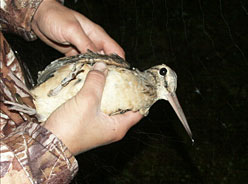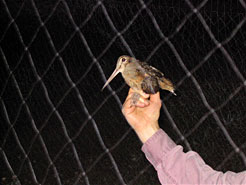Investigators: David E. Andersen, Scott Lutz (University of Wisconsin-Madison), and John Bruggink (Northern Michigan University)
Students: Kevin Doherty, M.S. (Wildlife Conservation – University of Minnesota), Jed Meunier, M.S. (Wildlife – University of Wisconsin-Madison), and Eileen Oppelt, M.S. (Biology – Northern Michigan University)
Little is known regarding fall movements, habitat use, and survival of American woodcock (Scolopax minor), particularly in the Central Management Unit. As part of a regional study to investigate these aspects of woodcock ecology, and to understand the impact of harvest on fall woodcock survival, in 2000 we initiated a 4-year study of fall woodcock ecology in the western Great Lakes region. Field work began in Minnesota in 2000, with parallel studies initiated in Wisconsin and Michigan in 2001. In Minnesota, Wisconsin, and Michigan, we identified a pair of study sites in close geographic proximity where woodcock habitat and population densities were similar. One of these areas was open to woodcock hunting, and the other was closed to woodcock hunting or experienced very low hunting pressure. On each study site, we annually captured and equipped 30-90 woodcock with radio transmitters in late summer and early fall, prior to the initiation of the woodcock hunting season. Subsequent to capture and release, we monitored survival and habitat use of radio-marked woodcock through the hunting season or until surviving woodcock migrated from study sites.
From 2001-2004 across all 3 states we captured and radioequipped 1,169 woodcock; 594 on hunted areas and 575 on non-hunted or lightly-hunted areas. Survival estimates during the hunting season were generally higher in non– or lightly-hunted than in hunted areas. However, survival estimates between study sites in the same state during the same year were not statistically different from one another, except in 2 instances. Survival was variable among years and sites, but highest in non-hunted areas, suggesting that hunting mortality may vary more than other causes of mortality. We also monitored a sub-sample of after-hatch-year (AHY) female woodcock intensively in each state and analyses of movement and habitat use data from these birds suggest that woodcock make primarily small-scale movements (47.7% <50 m between locations on subsequent days and 5.82 ha average 95% fixed-kernel home-range size) prior to migration. Primary cover types used were aspen (Populus spp.) seedling/sapling, aspen pole, alder (Alnus spp.), conifer, and willow (Salixspp.). Woodcock used edges within individual covers, but use of edge habitats was variable among habitat types and years. Results of this research have been incorporated into 3 M.S. theses (1 each at the University of Minnesota, University of Wisconsin – Madison, and Northern Michigan University), presented at multiple national and international conferences, and submitted for publication in the peer-reviewed scientific literature.
Acknowledgments: Primary funding for this project was provided by the U.S. Fish and Wildlife Service (Migratory Birds, Region 3 and the Webless Migratory Game Bird Research Program), U.S. Geological Survey (Science Support Program), the Minnesota Department of Natural Resources, the Wisconsin Department of Natural Resources, and the Michigan Department of Natural Resources.
Reports and Publications:
(pdf available)
Andersen, D.E., J.G. Bruggink, K. Doherty, R.S. Lutz, J. Meunier, and E. Oppelt. 2003. Fall survival, movements, and habitat use of American woodcock in the western Great Lakes region: 2002 field season report. Minnesota Cooperative Fish and Wildlife Research Unit, St. Paul, Minnesota.
Andersen, D.E., J.G. Bruggink, K. Doherty, R.S. Lutz, J. Meunier, and E. Oppelt. 2004. Fall survival, movements, and habitat use of American woodcock in the western Great Lakes region: 2003 field season report. Minnesota Cooperative Fish and Wildlife Research Unit, St. Paul, Minnesota.
Andersen, D.E., J.G. Bruggink, K. Doherty, R.S. Lutz, J. Meunier, and E. Oppelt. 2005. Fall survival, movements, and habitat use of American woodcock in the western Great Lakes region: 2004 field season report. Annual Progress Report. Minnesota Cooperative Fish and Wildlife Research Unit, St. Paul, Minnesota.
Doherty, K.E. 2004. Fall movement patterns of adult female American woodcock (Scolopax minor) in the western Great Lakes region. M.S. Thesis, University of Minnesota, St. Paul, Minnesota. 59pp.
Meunier, J. 2006. 2005. Fall migration chronology and habitat use of the American woodcock in the western Great Lakes region. M.S. Thesis, University of Wisconsin-Madison, Madison, Wisconsin. 116pp.
Oppelt, E.J. 2006. Fall survival of American woodcock in the western Great Lakes region. M.S. Thesis, Northern Michigan University, Marquette, Michigan. 48pp.
(Manuscript in preparation)
Andersen, D.E., M.E. Reiter, K.E. Doherty, and D.C. Fulton.Magnitude and spatial distribution of American woodcock hunting pressure in a central Minnesota wildlife management area. Proceedings of the 10th American Woodcock Symposium.
Doherty, K.E., D.E. Andersen, J. Meunier, E. Oppelt, R.S. Lutz, and J.G. Bruggink. Past patch quality as a predictor of future habitat selection: relating movement behavior of American woodcock to environmental factors.
Meunier, J., L.S. Lutz, K.E. Doherty, D.E. Andersen, E. Oppelt, and J.G. Bruggink.Fall diurnal habitat use by adult female American woodcock in the western Great Lakes region. Proceedings of the 10th American Woodcock Symposium.
Meunier, J., Song, R., R.S. Lutz, D.E. Andersen, K.E. Doherty, J.G. Bruggink, and E. Oppelt. Proximate cues for a short-distance migratory species: an application of survival analysis. Journal of Wildlife Management.
Oppelt, E., J.G. Bruggink, K.E. Doherty, D.E. Andersen, J. Meunier, and R.S. Lutz. Fall survival of American woodcock in the western Great Lakes region. Proceedings of the 10th American Woodcock Symposium.

